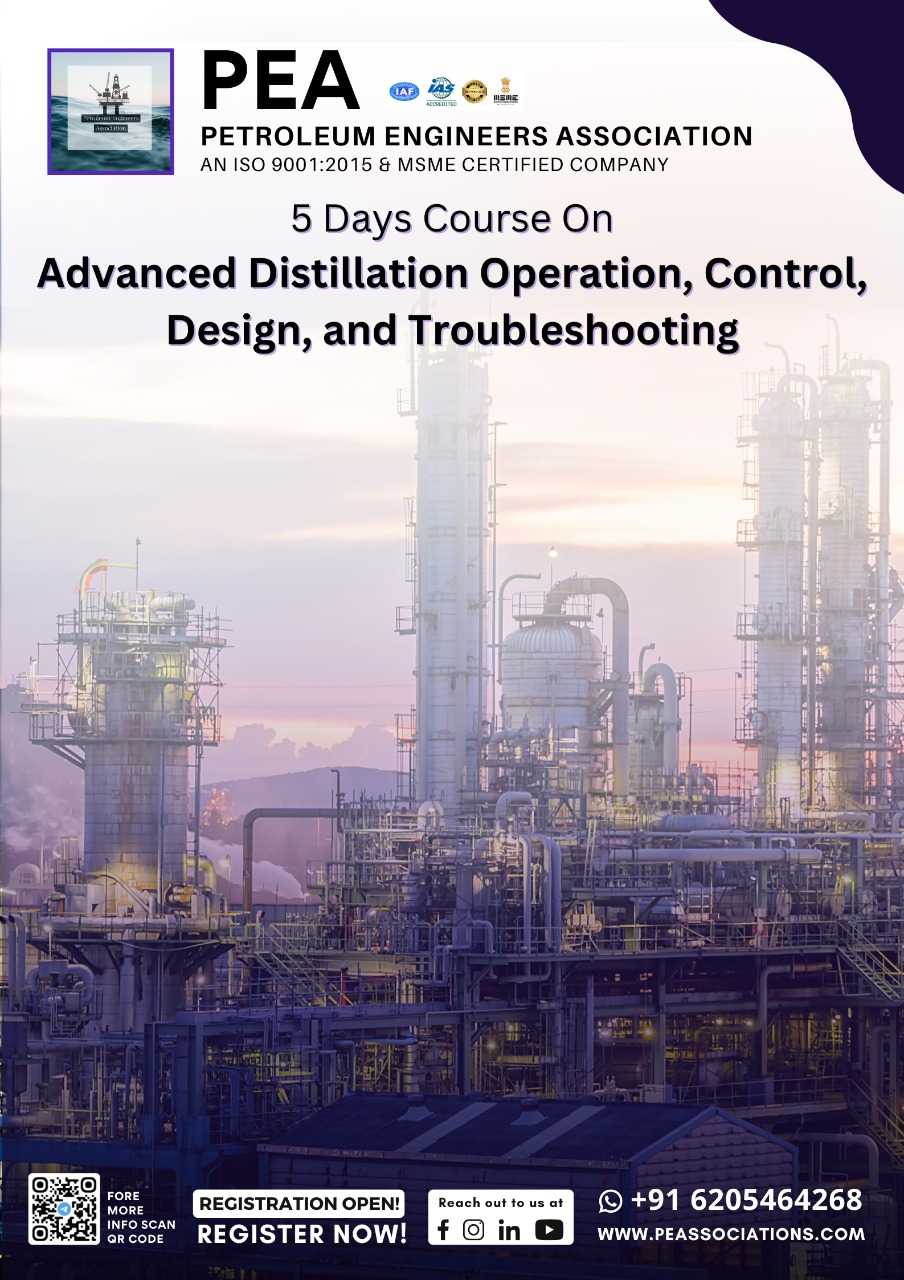Advanced Distillation Operation, Control, Design, and Troubleshooting
| Code | Date | Time | Duration | Location | Currency | Team of 10 Per Person | Team of 7 Per Person | Early Bird Fee Per Person | Normal Fee Per Person |
|---|---|---|---|---|---|---|---|---|---|
| PEA/RFD/26 | 09 - 13 Feb 2026 | 9 PM Indian Time |
15 Hours
|
Zoom Online
|
USD
|
2150
|
2250
|
2500
|
3000
|
Classes Will be from Monday to Friday Only Via Zoom Live Classes.
Boost your team's skills and your budget! Enjoy group discounts for collaborative learning. Send an inquiry to info@peassociations.com.
Advanced Distillation Operation, Control, Design, and Troubleshooting
Description
Distillation is one of the most widely used and critical separation processes in the oil, gas, and petrochemical industries. This advanced course is designed to give professionals a strong command of distillation fundamentals, modern design practices, process control strategies, and troubleshooting approaches. Participants will gain practical insights into improving efficiency, handling complex challenges, and ensuring smooth plant operations.
By the end of the training, attendees will have the knowledge and confidence to make informed decisions that enhance process performance, minimize downtime, and maximize productivity.
By the end of this course, participants will be able to:
-
Understand advanced distillation principles and applications.
-
Analyze and optimize distillation column design and operation.
-
Apply process control strategies to improve stability and efficiency.
-
Identify and resolve common operational issues and upsets.
-
Enhance troubleshooting skills for safe and reliable plant performance.
-
Develop strategies to reduce energy consumption and improve separation quality.
The course will be delivered through a combination of:
-
Engaging video lectures with clear explanations.
-
Real-life case studies and examples from the oil & gas industry.
-
Step-by-step walkthroughs of design and troubleshooting practices.
By enrolling staff in this training, organizations will:
-
Improve the reliability and efficiency of distillation units.
-
Reduce operational downtime and maintenance costs.
-
Strengthen safety culture by minimizing risks of process failures.
-
Enhance workforce competency in handling advanced process challenges.
Participants will gain:
-
Advanced technical knowledge in distillation processes.
-
Strong problem-solving and troubleshooting skills.
-
Confidence in making operational and design-related decisions.
-
Improved career prospects in refining, petrochemicals, and process industries.
This course is ideal for:
-
Process Engineers
-
Operation & Production Engineers
-
Plant Operators and Supervisors
-
Maintenance & Reliability Engineers
-
Design Engineers
-
Technical Managers and Team Leads
-
Professionals involved in distillation, refining, and separation processes
A. General Introduction
1. General Column Design
• The components of a distillation system, more than just a tower – it is a system of different components
• History of distillation
• Different types of distillation columns
• Differences among batch, flash, and multistage distillation process
• Relative advantages of tray and packed columns
• Steps in the process design
B. Thermodynamics and Equilibrium
1. Vapor Liquid Equilibrium
• Select the correct vapor-liquid equilibrium equation for your system
• Review vapor pressure and equilibrium diagrams
• Interpret mole fraction equilibrium curves, commonly called y-x diagrams
• Azeotropes and the challenges they create for distillation
2. Stages & Transfer Units Efficiencies
• Calculate the number of equilibrium stages using short cut methods
• Calculate minimum reflux and stages using graphical & analytical methods
• Determine number of theoretical stages needed in a distillation column
3. Stage Efficiency
• Methods for determining efficiency
• Calculate an overall column efficiency for tray columns
• Calculate point and tray efficiencies, and their difference
• Calculate the number and height of transfer units for packing
• Effects on distillation column by changing amount of reflux and reflux temperature
• How flooding and foaming affects efficiencies and capacities
C. Column Design
1. Tray Column Design
• The major design differences between tray types
• The operational limits for trays – operating window
• Size a distillation column for a given vapor and liquid rate
2. Packed Column Design
• The different types of packing and their characteristics
• The best type of packing for a given system
• Size a packed column diameter for a given vapor and liquid rate
3. Designing columns for fouling service
4. Designing columns for vacuum service
5. Designing Columns for improved operation and maintenance
E. Process Control
1. Distillation Column Control
• Functions of Process Control
• Characteristics of a Continuous Process
• Select appropriate composition and column pressure control schemes
• Process settings during column operation
2. Typical controlled and manipulated process variables
• Level
• Pressure
• Composition
• Temperature
• Flow
3. Controller Performance Criteria
• Final Control Elements
• Control Algorithms
• Open and closed loop tuning strategies
4. Feed Forward Control of an Ideal Process
• Feedback and Feed forward Control Loops
F. Troubleshooting
1. Introduction
• Evaluate operation of a packed column
• Evaluate operation of a tray column
• Use tools to diagnosis problems
2. Installation
• Common column installation mistakes
• List tasks to insure a proper installation
3. Commissioning
• Common start up problems and understand how to correct them
4. Utilizing Process Engineering Software for troubleshooting.
On successful completion of this training course, PEA Certificate will be awarded to the delegates
Frequently Asked Questions
All course bookings made through PEA are strictly non-refundable. By registering for a course, you acknowledge and accept that all fees are payable in full and are not subject to refund under any circumstances, including changes in personal or professional commitments or partial attendance.
PEA reserves the right to make reasonable adjustments to course content, trainers, or schedules where necessary, without entitling delegates to a refund. Comprehensive details of each course — including objectives, target audience, and content — are clearly outlined before enrolment, and it is the responsibility of the delegate to ensure the course's suitability prior to booking.
For any inquiries related to cancellations or bookings, please contact our support team, who will be happy to assist you.



